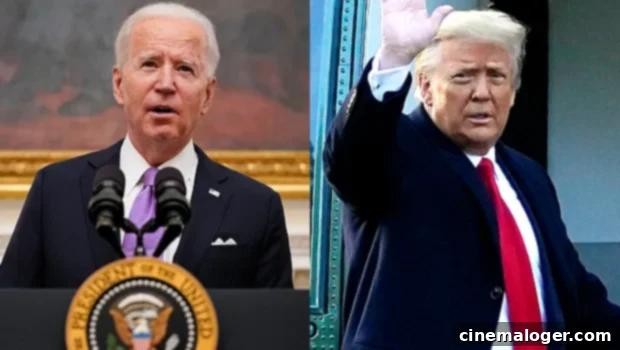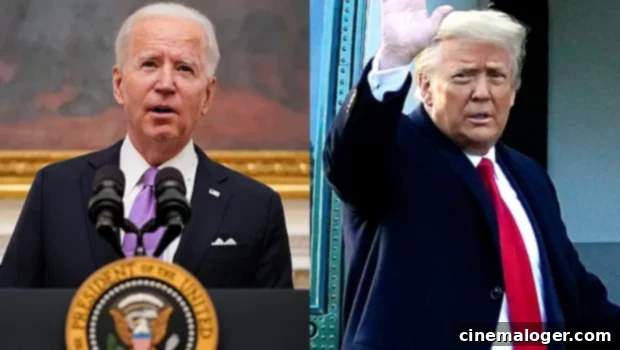Joe Biden Signals a New Era by Removing Donald Trump’s Iconic Oval Office Diet Coke Button
Upon taking office, President Joe Biden swiftly initiated a series of changes, both significant and symbolic, marking a clear departure from his predecessor’s era. Among the earliest and most talked-about alterations in the Oval Office was the disappearance of a peculiar fixture: a small wooden box adorned with a red button. This device, famously installed by Donald Trump, served a singular purpose – to summon a butler who would immediately deliver a Diet Coke to the then-president.
The absence of this distinctive item from the historic Resolute Desk has been interpreted by many as a subtle yet potent symbol of a new presidential style, one that emphasizes a return to traditional decorum and perhaps, a less personalized, more understated approach to the nation’s highest office. The contrast between the two presidents’ approaches to even the minutiae of their working environment has captivated public and media attention, highlighting differing philosophies on leadership and the symbolic power of the White House.
The Origins of a Presidential Perk: Donald Trump’s Diet Coke Button
During his four years in the Oval Office, Donald Trump cultivated a presidential image that was often intertwined with his personal brand and distinct habits. A well-known aficionado of Diet Coke, Trump’s reported daily consumption of the beverage was a frequent topic of discussion. To cater to this preference, a unique system was put in place: a red button, prominently positioned on the Resolute Desk, which when pressed, would result in the immediate arrival of a chilled can of Diet Coke, presented by a White House butler on a silver platter. This highly personalized service became an iconic, if somewhat eccentric, hallmark of his presidency.
President Biden has removed the Diet Coke button. When @ShippersUnbound and I interviewed Donald Trump in 2019, we became fascinated by what the little red button did. Eventually Trump pressed it, and a butler swiftly brought in a Diet Coke on a silver platter. It’s gone now. pic.twitter.com/rFzhPaHYjk
— Tom Newton Dunn (@tnewtondunn) January 21, 2021
The existence of this “Diet Coke button” was first widely reported by journalists who interviewed Trump in the Oval Office. Tom Newton Dunn, then the political editor for The Sun and now Chief Political Commentator for the U.K’s Time Radio, explicitly detailed his experience in a tweet, recounting how he and a colleague were intrigued by the button, only for Trump to press it and demonstrate its immediate utility. This detail quickly became a viral anecdote, emblematic of Trump’s unique approach to the privileges and personalized services associated with the presidency.
For many, the button symbolized a degree of presidential indulgence, a ready symbol of executive power extended even to personal creature comforts. Its presence spoke volumes about a president who was known for his demanding style and his preference for immediate gratification. The Red Button, nestled among more conventional Oval Office instruments like landline telephones (which remain on Biden’s desk), stood out as a distinctly personal touch in a historically significant workspace.
Biden’s Subtle Statement: A Return to Traditional Presidential Aesthetics
New photographs of President Biden working at the Resolute Desk, released shortly after his inauguration on January 20, 2021, conspicuously revealed the absence of the red button. This swift removal, without fanfare or official announcement, spoke volumes. It was not merely about a beverage preference; it was about symbolism, presidential demeanor, and the tone of the administration. Biden, known for his more traditional political background and a stated desire to “restore the soul of America,” appears to favor an Oval Office environment that is less personalized and more aligned with historical presidential aesthetics.
The removal of the button signifies a deliberate move away from the highly personalized and often unconventional style of his predecessor. It suggests an administration less focused on personal indulgences and more on the gravitas and collective responsibility of the office. This seemingly minor change underscores a broader commitment to re-establishing certain norms and traditions that many observers felt had been eroded during the previous administration. It reflects a preference for a White House that is seen as a symbol of institutional continuity rather than individual persona.

President Joe Biden immediately got rid of predecessor Donald Trump’s ‘Diet Coke button’ on the Oval Office’s Resolute Desk. Photo credit: AP.
The Resolute Desk: A Stage for Presidential Styles
The Resolute Desk itself is more than just a piece of furniture; it is an artifact steeped in history and symbolism. Crafted from the timbers of HMS Resolute, a British Arctic exploration ship, and gifted by Queen Victoria to President Rutherford B. Hayes in 1880, it has been used by nearly every American president since Franklin D. Roosevelt. Its presence in the Oval Office makes it a silent witness to countless moments of decision-making, crisis management, and national leadership.
Each president who has occupied the Oval Office has, in some way, left their mark on the space, often through personal mementos, photographs, or, in Trump’s case, functional additions. The items placed on the Resolute Desk become extensions of the president’s personality and priorities. Trump’s Diet Coke button, therefore, was not merely a convenience; it became part of the desk’s narrative during his tenure, a reflection of his distinctive character and a minor piece of presidential history. Biden’s decision to remove it, therefore, is not just about clearing clutter; it’s about reasserting a different narrative for the desk and the office it represents.
Contrasting Presidential Habits: From Diet Coke to Decorum
Donald Trump’s Habits and Persona
Donald Trump’s dietary preferences and personal habits were frequently discussed throughout his presidency. His well-documented love for fast food, including Big Macs and fries, alongside his extensive consumption of Diet Coke, became part of his public persona. These habits, while personal, were often framed by his supporters as relatable or as a rejection of elitist Washington norms. The Diet Coke button perfectly encapsulated this blend of personal preference and presidential privilege, making a highly specific demand readily fulfillible by White House staff. Reports suggested he consumed upwards of a dozen Diet Cokes daily, underscoring the necessity of such a dedicated service button for his convenience.
Joe Biden’s Approach to the Presidency
In stark contrast, Joe Biden projects an image of a more traditional and less overtly demanding leader. While he is known for his fondness for ice cream, his public habits do not include the same level of personalized indulgence seen with the Diet Coke button. His administration has emphasized a return to established protocols and a more formal, dignified approach to the presidency. The removal of the button aligns with this broader philosophy, signaling a preference for an environment where the focus remains on policy and governance, rather than on personal conveniences that might be perceived as excessive.
Public and Media Reaction: A Small Detail, A Big Conversation
The news of the Diet Coke button’s removal quickly went viral, igniting a flurry of reactions across social media and news outlets. For many, it was a source of amusement, while for others, it was a telling sign of a larger cultural and political shift. Twitter, in particular, had a “field day” with the topic, with users posting humorous takes, pointed critiques, and expressions of relief or satisfaction.
Trump had a Diet Coke button and when he pressed it, a butler showed up with a Diet Coke.
Just wow!
Maybe they can install that in Mar-A-Lago, but we are classing up the White House.
— Brian O’Sullivan (@osullivanauthor) January 21, 2021
Author Elizabeth May expressed a common sentiment of incredulity and slight embarrassment, noting, “So many people are asking if this is a joke, and I regret to inform you all it is not. that button really was to order a diet coke. he reportedly drank 12 cans a day. I hate that I know this.” This highlights the mixture of disbelief and fascination that surrounded the button during Trump’s tenure. Veteran political analyst Jeff Greenfield offered a satirical take, joking about a hypothetical letter from Trump to Biden detailing the functions of various colored buttons, including one for “BigMac and Fries” and another for “Diet Coke,” playfully hinting at the potential for confusion or absurdity.
I would’ve paid so much money to get to be in the room for the conversation that I imagine went like:
BIDEN: ok what’s next
STAFFER: setting up the Oval. Photos are all done. Do you want to keep the Diet Coke button?
BIDEN:
STAFFER:
BIDEN: the what in god’s name button https://t.co/cDhkmqzjr5
— Emmy Bengtson (@EmmyA2) January 21, 2021
The conversation also extended to broader implications for the White House. Users like @osullivanauthor quipped about “classing up the White House,” suggesting that the button’s removal was part of a broader effort to restore a sense of dignity and professionalism to the executive mansion. The extensive social media engagement underscores how even small symbolic changes in the Oval Office can capture the public imagination and serve as a focal point for discussions about presidential leadership and national identity.
Beyond the Button: Implications for White House Staff and Protocol
While the Diet Coke button was largely a matter of presidential preference, its existence and removal also carry implications for the dedicated staff who serve the White House. The original article highlights a user’s hope that White House career staff, including housekeepers, ushers, and cooks, would now “be treated with respect again, and no longer have fear of being berated, screamed at, or fired.” This sentiment points to a significant aspect of presidential transitions: the impact of a president’s leadership style on the morale and daily lives of the hundreds of individuals who keep the executive branch running.
White House staff, often referred to as “silent warriors,” maintain a high degree of professionalism and discretion, serving administrations regardless of political affiliation. However, the atmosphere and demands placed upon them can vary significantly from one president to another. Joe Biden is widely known for his kindness, empathy, and respect towards his staff and those around him, a reputation built over decades in public service. His approach contrasts sharply with previous reports of a more demanding or sometimes volatile environment for staff. The absence of a “Diet Coke button” and the implicit expectation of instant, personalized service reflects a shift towards a more conventional and perhaps less personalized relationship with the White House support teams, potentially fostering an environment where staff feel more valued and less subjected to arbitrary demands. This change, while seemingly minor, can contribute to a significant improvement in the working environment for many within the White House.
Conclusion: A Subtle Shift, A Clear Message
The removal of Donald Trump’s Diet Coke button from the Oval Office’s Resolute Desk by President Joe Biden is far more than a trivial detail; it is a powerful symbolic gesture. It represents a clear and immediate statement of intent from the new administration: a departure from the highly individualized and often unconventional style of the previous presidency, towards a return to established norms, professionalism, and a more traditional understanding of presidential decorum.
This small physical change encapsulates a larger narrative of transition – a shift in tone, priorities, and leadership philosophy. It underscores Biden’s commitment to projecting an image of sobriety and institutional reverence, marking a conscious effort to redefine what it means to occupy the nation’s highest office. In the grand tapestry of presidential transitions, while policy changes often dominate headlines, these subtle symbolic acts frequently resonate deeply with the public, communicating profound shifts in governance and national identity. The disappearance of the Diet Coke button serves as an eloquent, silent declaration of a new era in the White House.
